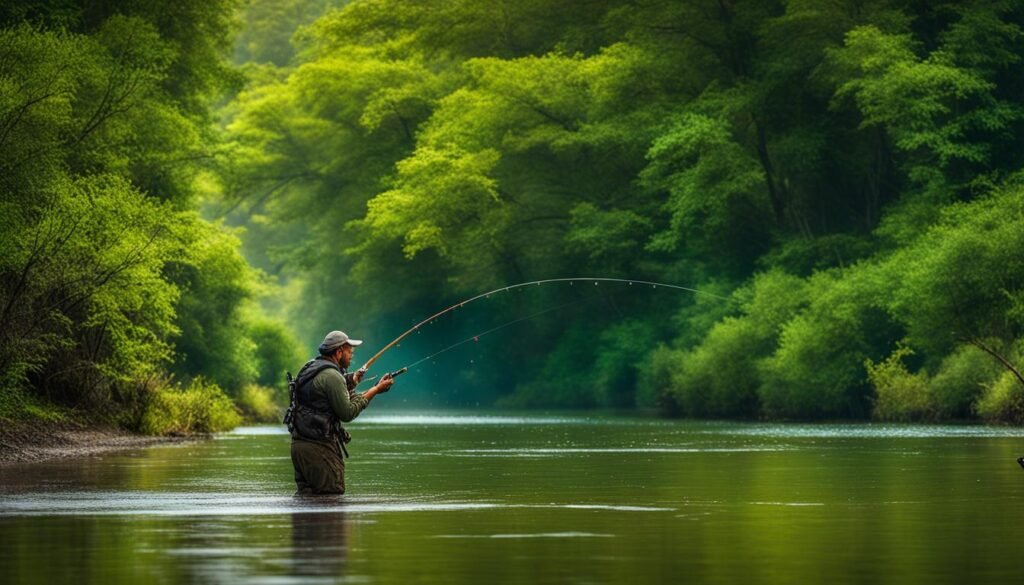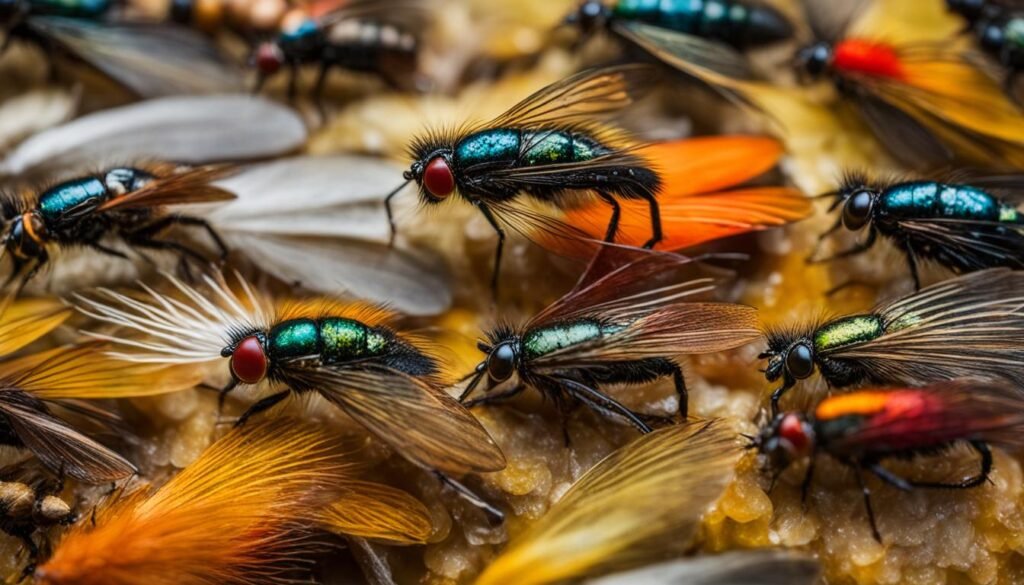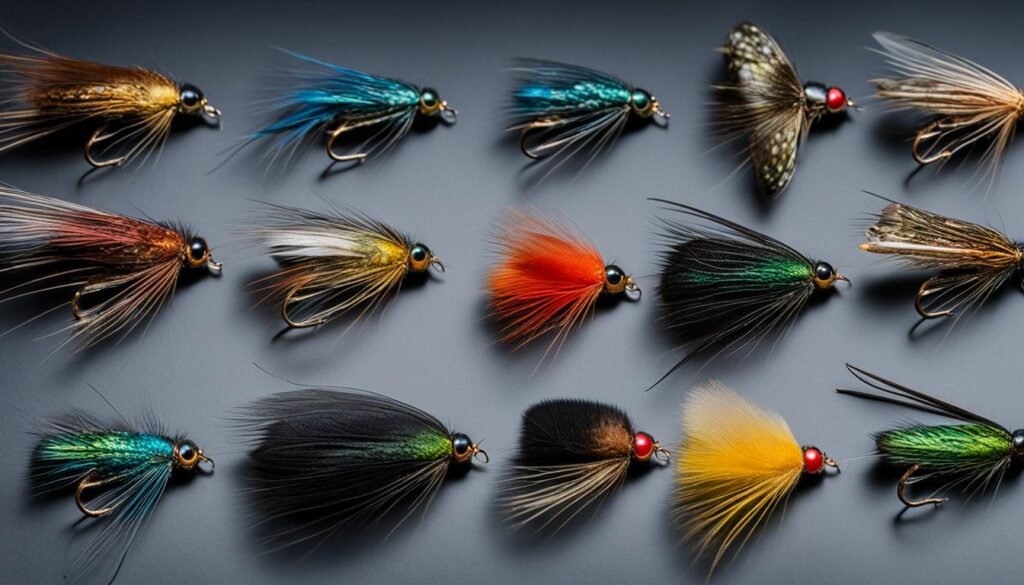What exactly are wet flies and why are they so effective? Wet flies are expertly designed to imitate a variety of underwater insects and food sources. Their lifelike appearance and movement make them irresistible to trout and other fish species. From imitating caddis hatches to mimicking drowned mayfly adults, wet flies cover a wide range of aquatic insect life cycles.
Let’s dive deeper!
The History of Wet Flies
The history of wet flies in fly fishing is deep-rooted and fascinating. These flies have been used for centuries, with traditional wet flies originating in the 1800s. Originally, European fly fishers used wet flies to target Atlantic Salmon. These flies, adorned with soft hackle collars or feathered wings, were often swung in the current to entice strikes. The tradition of using wet flies has since evolved, incorporating modern synthetic materials that allow for innovative designs and increased fishing capabilities.
Modern wet flies offer anglers a wide range of options, each with its own unique design and purpose. While traditional wet flies maintain their charm and effectiveness, contemporary patterns have been developed using synthetic materials that imitate various underwater insects and food sources. These modern wet flies have proven to be highly successful in enticing fish and expanding the angler’s possibilities on the water.
The evolution of wet flies showcases the artistry and ingenuity of fly fishing enthusiasts throughout history. From the humble beginnings of traditional wet flies to the cutting-edge designs of modern patterns, these flies continue to be an essential part of an angler’s arsenal. The history of wet flies not only pays homage to the pioneers of fly fishing but also provides a foundation for continuous innovation in the pursuit of the perfect cast and the thrill of the catch.
The Advantages of Traditional and Modern Wet Flies
- Traditional Wet Flies: These flies are steeped in history and have a timeless appeal. Their classic design and natural materials often mimic the appearance of insects in the water, making them highly effective in fooling finicky fish.
- Modern Wet Flies: These flies utilize synthetic materials that offer enhanced durability and lifelike movement in the water. They provide anglers with a wider variety of colors, shapes, and sizes to match the specific insect hatches in their fishing area.
What Do Wet Flies Imitate?
Wet flies are incredibly versatile and can imitate a wide range of underwater insects and food sources, making them an essential part of any fly fisherman’s arsenal. They are particularly effective at mimicking caddis hatches and mayfly nymphs. When it comes to caddis pupa, soft hackle wet flies are the go-to choice. These flies perfectly mimic the swimming action and profile of the pupa, fooling hungry trout into thinking it’s an easy meal.
In addition to imitating caddis pupa, wet flies can also effectively imitate mayfly nymphs. After a mayfly hatch is over, drowned adults are present in the water, making wet flies a great choice to replicate this stage of the insect’s life cycle. The lifelike movement and appearance of wet flies make them irresistible to trout and can lead to some exciting action on the water.
What makes wet flies so effective at imitating these insects is their ability to sink and move in the water column. Their soft hackle collars or feathered wings create a realistic profile, while the materials used in their construction offer lifelike movement. With their versatility and ability to imitate insects throughout their life cycle, wet flies are a must-have for any fly fisherman looking to increase their chances of success on the water.
How to Fish with Wet Flies

When it comes to wet fly fishing, there are several techniques you can use to maximize your chances of success. Whether you’re a beginner or a seasoned angler, learning how to fish with wet flies can greatly enhance your fishing experience. Here are some techniques to consider:
- Fishing under a strike indicator: This technique involves casting your wet fly and allowing it to drift in the current under a strike indicator. The indicator will help you detect any strikes and ensure that your fly is presenting naturally in the water.
- The Leisenring Lift: This technique is particularly effective when fishing wet flies near the bottom of the river. After casting your fly and allowing it to sink, slowly lift your rod to simulate the movement of emerging or swimming insects. This can entice strikes from trout that are feeding near the riverbed.
- Swinging wet flies: This technique involves casting your wet fly across the current and letting it swing downstream. The swinging motion mimics the natural movement of insects that are being carried by the current. It’s important to vary the speed and depth of your swing to find what the fish are most responsive to.
Each fishing technique has its own advantages and can be effective in different situations. It’s important to experiment with different techniques and observe the behavior of the fish in order to determine which method is most productive on a given day.
Choosing the Right Wet Fly
When selecting wet flies for your fishing trip, it’s important to consider the specific conditions and the preferences of the fish you are targeting. Here are a few tips to help you choose the right wet flies:
- Consider the insect life cycle in the area you are fishing. Matching the hatch is often key to success with wet flies.
- Pay attention to the size, shape, and color of the natural insects in the water. Try to select wet flies that closely imitate these characteristics.
- Experiment with different patterns and sizes to see what the fish are most responsive to on a given day.
- Keep a variety of wet flies in your tackle box to cover a range of fishing conditions and situations.
Selecting the Best Wet Flies

When it comes to selecting the best wet flies for your fly fishing trip, several factors should be taken into consideration. These factors include the insect life cycle in the area you’ll be fishing, the water conditions you’ll encounter, and your personal preferences as an angler. Here are some tips to help you make the right choices:
1. Consider the insect life cycle:
- Research the insect species that are prevalent in the area you’ll be fishing. Find out which insects fish are feeding on and try to match their natural prey with wet fly patterns.
- Pay attention to the different stages of the insect life cycle, such as nymphs, pupae, and emergers. Choose wet flies that imitate these stages to increase your chances of success.
2. Assess the water conditions:
- Observe the clarity and color of the water. In clear water, natural-looking patterns and subtle colors tend to work best. In stained or murky water, brighter and larger wet flies can be more effective.
- Take into account the water temperature. Fish may be more active and feeding closer to the surface in warmer water, so consider using wet flies that imitate insects in the upper water column.
3. Personalize your selection:
- Experiment with different wet fly patterns to see what works best for you and the fish in a specific location. Keep track of your successes and failures so you can refine your selection over time.
- Don’t be afraid to try new wet fly patterns that catch your eye. Fish can become conditioned to certain patterns, so mixing it up can sometimes trigger strikes from wary fish.
Best Fly Line for Fishing with Wet Flies
When it comes to fishing with wet flies, choosing the right fly line is essential for optimal casting and presentation. The type of fly line you use can greatly impact your fishing success.
A floating fly line is the most commonly used line for fishing with wet flies. It allows for better control and manipulation of the fly, making it easier to imitate the natural movements of underwater insects. With a floating line, you can effectively fish wet flies near the surface or in shallow water, where fish are often feeding.
However, there are situations where a sinking fly line may be more suitable. If you need to fish your wet flies at deeper depths, a sinking line can get your flies down to the desired level. This is especially useful when targeting fish that are holding deep or in fast-moving currents.

